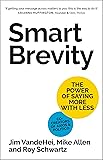
Smart Brevity

He is a gruff, grumpy, no BS journalistic throwback—and distills perfectly what every initial sentence should do: “Just tell me something I don’t f@$&ing know.”
Jim VandeHei • Smart Brevity
Put your readers first. People are busy and have expectations of the precious time they give you. All they usually want to know is what’s new and “Why it matters.” Give them that.
Jim VandeHei • Smart Brevity
The most important words you type are subject lines, headlines and the first line of tweets, notes or papers. You need to grab me, entice me, seduce me.
Jim VandeHei • Smart Brevity
Now read all three parts together: your headline, your first-sentence lede and your Axiom. If this is all a person hears and learns, does it convey what matters most to you in the most blunt and understandable way possible? If the answer is yes, you have done more in 200 words than most people do with 20,000.
Jim VandeHei • Smart Brevity
in a haze of words. This was during
Jim VandeHei • Smart Brevity
Start by accepting that most people will scan or skip most of what you communicate—and then make every word and sentence count.
Jim VandeHei • Smart Brevity
And then try to do all of this on one screen of a phone, regardless of what it is. Voilà . . . Smart Brevity.
Jim VandeHei • Smart Brevity
The first sentence is your one—and likely only—chance to tell someone what they need to know and convince them not to move on.
Jim VandeHei • Smart Brevity
Always do this before you start communicating. If you try to speak to everyone, usually you reach no one. Singling out the person you want to reach clarifies things big-time.